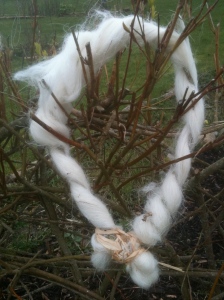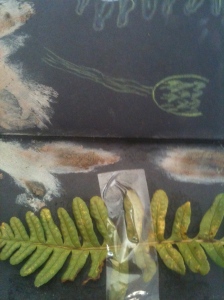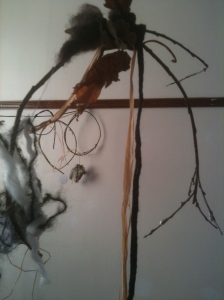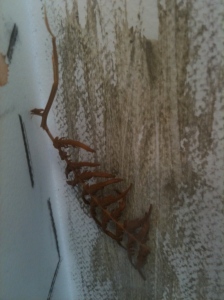Campfire, Shelter, and Bundles
April 10, 2011
 LANDMARKS: NATURE, ART, SCHOOLS
LANDMARKS: NATURE, ART, SCHOOLS
Week 9 – 21 New Participants, 17 Repeat Participants
Total Landmark Participants: 166
Location: Ardee Library
Participant Feedback:
“The children really enjoyed visiting each art station and working with the different art materials. It was lovely to see the children so engrossed with their work. They seemed really excited at having the opportunity to use materials for art that they might not get to use at school. They particularly loved the ink stampers and drawing work, using beautiful photos as inspiration. Excellently explained and a fun experience” Monastery National School Ardee, Teacher (2nd Class)
“The important part of the project was the link with the classroom, bringing the artworks back into the classroom offered continuity. It meant that we could create our own environment. The project was structured, but free, focussed and yet we could make it our own” Ardee Educate Together National School, Teacher (5/6th Class)
The featured artist this week was Chris Drury, known for his stone and branch shelters, cairns with fire, and collections of natural materials, which he calls bundles.
In his book, Silent Spaces, Drury describes the protectiveness offered by his huts or shelters made within remote wild areas around the world.
Within a classroom a small shelter can be a place to ‘be apart’, to go inside one’s self for a moment, before re-entering classroom activity.
“I like the way that a shelter has an interior as well as an exterior. They feel different but are connected. I like the way this interior space draws you inside yourself, enclosing, protecting, just as mountains pull you outside yourself, pushing mind and body beyond their usual confines” (Chris Drury, Silent Spaces, p. 20). A shelter has a presence, both in nature, and also indoors. The fact that it can be entered into, embraces or surrounds a child unto themselves. Within the Ardee Library, a willow shelter resides within the corner of the art room. A quiet ending to a period of creative work can be achieved by asking each child to enter the shelter for a few moments to be by themselves. The rest of the class ‘holds’ the silence for their classmate, as they enter the shelter.
Drury also collects simple natural objects to create bundles, which become symbolic, representing a particular place, season, and habitat. A bundle, writes Drury, is like a souvenir, “they are talismans of time and place, made simply at a campsite, or alternatively made at a later date as an act of remembering. A stick is a forest, a stone is a mountain” (Chris Drury, Silent Spaces, p. 58). Children can easily make their own bundles from sticks, moss, pinecones and sheep’s wool.
Students can also re-create the ‘fire’ of Drury’s artworks by using clay, sticks and candles. Each Landmark’s session begins and ends around a candle campfire situated in the middle of the art room. The campfire is a gathering place, a resting place within a landscape, and a stopover within a long journey. Drury creates fires within stone cairns in remote mountain areas, along cliffs, or by falling water. They mark “moments of exhilaration” along long walks, or the contrasts between stone, water, time, light, and sky. The campfire is also evoked in the art sessions through the use of charcoal, literally burnt wood taken from old campfires situated in local forest parks. The children work with the black wood in their paper books.
The photos featured are artworks from students of Monastery National School, Ardee Educate Together and Scoil Mhuire na Trocaire.
Three Dimensional Nature Collages, Wood and Nature Prints
March 27, 2011
LANDMARKS: NATURE, ART, SCHOOLS
Week 7 – 20 Repeat Participants, 16 New Participants
Total Landmark Participants: 128
Participant Feedback:
“Each stone on the ground has it’s own identity and can be seen in different views just like every human being. Using mud is lots of fun, and feels nice on my fingers. Looking at nature closely, we can see lots of amazing shapes and sculptures, something we might not notice at a quick glance” Ardee Educate Together National School, Teacher, (5/6th Class)
“The variety of mediums for the children were brilliant. The children enjoyed the experience of being at one with nature. It was a very stimulating and fun experience for the children. I would like to use more nature in the classroom. I loved the bird sounds” Tir na Nog Montessori Playschool Teacher, Dunleer
“A wonderful relaxing fun time workshop. Pamela has set up a truly inspiring room with loads of exciting pictures and pieces of art. Loads of paints, pastels, and objects of fun to experiment with. My daughter and myself have enjoyed the class and will definitely be coming back” Parent, Saturday Family Workshop
“A really enjoyable and stimulating time spent with lots of natural materials and working them into art. The most enjoyable piece is that there was no right or wrong way of doing the art or of using any of the materials. It was lovely to have free expressiveness through art” Parent, Saturday Family Workshop
The themes for this week’s artwork were three dimensional nature collage and wood and nature prints.
The natural collages pictured here were made by students of Ardee Educate Together National School. They were inspired by the artwork of Andy Goldsworthy, a land artist who works within natural landscapes assembling natural elements into sculptural forms. Andy Goldsworthy photographs his site-specific sculptures before they float away, melt, decay, or fall to the ground. “Movement, change, light, growth, and decay are the life-blood of nature, the energies I try to tap through my work. When I work with a leaf, rock, stick, it is not just material in itself, it is an opening into the processes of life within and around it” (Andy Goldsworthy quoted in Balance: Art and Nature by John K. Grande).
Wood and nature prints were explored within a Saturday Family Workshop at the Ardee Library. Copper and bronze paint was applied to blocks of chopped wood, pine cones, stones, and oak leaves to produce abstract impressions upon paper. These prints captured textures and the surfaces of natural objects in an experimental way.

Nature Classroom
March 20, 2011
LANDMARKS: NATURE, ART, SCHOOLS
Week 6 – 46 Repeat Participants, 1 New Participant
Total Landmark Participants: 112
Location: Ardee Library and Scoil Mhuire na Trocaire National School, County Louth

Feedback:
“The children had a great use of natural materials. They became familiar with how flexible willow branches are and every child used a willow branch to create a ‘crown’ for their heads. The sheep’s wool was a great material for the girls to work with!”
“Over the past four weeks we have been working with various natural materials, creating the most fantastic art! We have brought the outdoors inside our classroom! This experience has been brilliant for the girls as it has most certainly enabled them to become more open and expressive with nature” Scoil Mhuire na Trocaire, Teacher (4/5th Class)
Thirty-one students of Scoil Mhuire na Trocaire National School participated in four Landmarks workshops. They created an installation of nature based artworks for their classroom.
When asked about the project, the students offered the following responses:
“Our classroom feels like a forest”
“The art from nature creates a nice atmosphere in the classroom”
“I like to feel nature around me, while I work”
“Sometimes I am distracted by the art, because I like to look at it”
“It makes me feel more awake, warm and cosy”
“I feel more relaxed with nature around me”
“I like the scent of the pine, it makes my mind clearer”
“I feels like I can be outside, even when I’m inside”
“It makes me more relaxed and I think differently”
The students also created a word list describing their experience after their final workshop in the Ardee Library:
“Happy, cheerful, free, joyful, creative, excited, warm, cool, relaxed, calm, an adventure”
The photos are the hands of students working with willow, a wool crown and artist books by students of Scoil Mhuire na Trocaire.
Making a Path through a Studio
March 6, 2011
 LANDMARKS: NATURE, ART, SCHOOLS
LANDMARKS: NATURE, ART, SCHOOLS
Week 4 – 32 New Participants, 30 Repeat Participants
Total Landmark Participants: 111
Location: Ardee Library, County Louth
Feedback:
“We had a lovely morning – it was so relaxing and I could tell that all of the children enjoyed themselves so much – something that isn’t always easy in the classroom. They used all the materials and created beautiful pieces of art work, which look so creative and natural in the classroom! Collon National School, Teacher (2nd Class).
“It’s the best nature place to be in, ” Student (2nd Class), Collon National School
” Student (2nd Class), Collon National School
“It felt like being in a cave,” Student (2nd Class), Collon National School
“It was the best day,” Student (2nd Class), Collon National School
Each Landmarks workshop, involves walking a path of art stations, which contain different art materials and activities. Walking and making art through an indoor route, can be like walking a path outdoors, observing and engaging with different experiences along the way.
Children are offered an opportunity to work in silence, while natures sounds are playing in the background. Each week one or more different land artists are profiled. This includes showing pictures of their art and talking about their methods of making art from natural materials, or within natural environments. The land artists’ ways of making art, are an engaging starting point for children to learn about how to work creatively with nature. Artists can re-shape our ideas about life experience in general, and in the case of land artists they also re-shape how we perceive and interact with the natural world.
Artists can re-shape our ideas about life experience in general, and in the case of land artists they also re-shape how we perceive and interact with the natural world.
Drawing on their ‘feel’ of mud, bog, branches, moss, leaves, charcoal and natural wool children can instinctively mark the pages of their artist books with their own inner experiences. The opportunity to work freely, through touch and instinct, can fuel both imagination and ideas. By working through stops along an indoor path of art materials (within a limited period of time) children can focus their expression, and be involved in the activity of ‘making’. Changing the pace and materials of their art making, means that children do not have time to ‘get in right,’ but instead work with what’s at hand and the impulse to experiment. These are skills that can be transferred to other areas of their life, as the ability to experiment can be useful for learning and developing self confidence.
The pictures are small artist books created by Collon National School students, 2nd Class.
Re-shaping Space – Assembling a Classroom Habitat
February 12, 2011
LANDMARKS: NATURE, ART, SCHOOLS
Week 1
Total Participants – 48
Location: Ardee Library, County Louth
Feedback:
“The workshop was very different and experimental, and offered creative freedom. The students were so interested they didn’t want to go,” Ardee Educate Together National School, Principal and Teacher (5/6 Class)
“That was really cool,” Student Ardee Educate Together National School (5/6th Class)
“A brilliant morning and they were all so keen” Ardee Brigin and Girl Guides
Transforming classroom space into a different kind of surrounding for students, is one of the goals of Landmarks: Nature, Art, Schools. Site-specific installation art is assembled for a particular space, and it is often composed from a collection of different ingredients. It is not unlike a three dimensional nature table, where organic materials are suspended, placed on the ground, and displayed on walls. It is an environment within reach of students, and may also become a den, shelter or breathing space within the school day. An installation encompasses an area, it can be entered into, and invites interaction. It offers a set of physical conditions which can affect the nature of the individual.
Incorporating ceiling hooks for suspending artworks can change the shape of a classroom. String, wool or wire can be hung from the hooks, so that students’ artworks can be attached over time. More dimensions are added to the overall classroom space, with layers of string/wool/wire becoming webs or geometrical patterns.
Assembling a collection of individual artworks into a larger entity, is an example of biodiversity. It is a habitat, whereby different kinds of artworks and people accommodate diversity. Different approaches, perspectives and ways of handling materials are brought together in one creative space. The fact that this habitat is mostly ‘natural’ means that it constantly changes, both growing and decaying at the same time.



